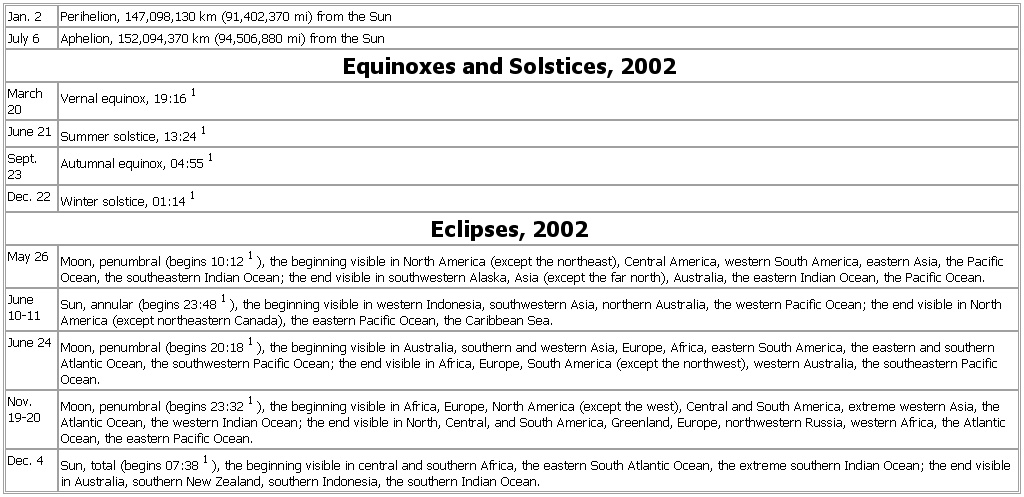Earth Perihelion and Aphelion, 2002
- Earth Perihelion and Aphelion, 2002
-
Earth Perihelion and Aphelion, 2002
Jan. 2 Perihelion, 147,098,130 km (91,402,370 mi) from the Sun
July 6 Aphelion, 152,094,370 km (94,506,880 mi) from the Sun
Equinoxes and Solstices, 2002
March 20 Vernal equinox, 19:161
June 21 Summer solstice, 13:241
Sept. 23 Autumnal equinox, 04:551
Dec. 22 Winter solstice, 01:141
Eclipses, 2002
May 26 Moon,
penumbral (
begins 10:121),
the beginning visible in North America (
except the northeast),
Central America,
western South America,
eastern Asia,
the Pacific Ocean,
the southeastern Indian Ocean;
the end visible in southwestern Alaska,
Asia (
except the far north),
Australia,
the eastern Indian Ocean,
the Pacific Ocean.
June 10-
11 Sun,
annular (
begins 23:481),
the beginning visible in western Indonesia,
southwestern Asia,
northern Australia,
the western Pacific Ocean;
the end visible in North America (
except northeastern Canada),
the eastern Pacific Ocean,
the Caribbean Sea.
June 24 Moon,
penumbral (
begins 20:181),
the beginning visible in Australia,
southern and western Asia,
Europe,
Africa,
eastern South America,
the eastern and southern Atlantic Ocean,
the southwestern Pacific Ocean;
the end visible in Africa,
Europe,
South America (
except the northwest),
western Australia,
the southeastern Pacific Ocean.
Nov.
19-
20 Moon,
penumbral (
begins 23:321),
the beginning visible in Africa,
Europe,
North America (
except the west),
Central and South America,
extreme western Asia,
the Atlantic Ocean,
the western Indian Ocean;
the end visible in North,
Central,
and South America,
Greenland,
Europe,
northwestern Russia,
western Africa,
the Atlantic Ocean,
the eastern Pacific Ocean.
Dec. 4 Sun, total (begins 07:381), the beginning visible in central and southern Africa, the eastern South Atlantic Ocean, the extreme southern Indian Ocean; the end visible in Australia, southern New Zealand, southern Indonesia, the southern Indian Ocean.
See as table:
1Universal time.
Source: The Astronomical Almanac for the Year 2002 (2001).
* * *
Universalium.
2010.
Look at other dictionaries:
Earth Perihelion and Aphelion, 2003 — ▪ Table Jan. 4 Perihelion, 147,102,650 km (91,405,350 mi) from the Sun July 4 Aphelion, 152,100,360 km (94,510,780 mi) from the Sun Equinoxes and Solstices, 2003 March 21 Vernal equinox, 01:001 June 21 Summer solstice, 19:101 Sept. 23 Autumnal… … Universalium
Mathematics and Physical Sciences — ▪ 2003 Introduction Mathematics Mathematics in 2002 was marked by two discoveries in number theory. The first may have practical implications; the second satisfied a 150 year old curiosity. Computer scientist Manindra Agrawal of the… … Universalium
Earth — This article is about the planet. For other uses, see Earth (disambiguation). Earth … Wikipedia
2002 AA29 — Infobox Planet | discovery=yes | physical characteristics = yes | bgcolour=#FFFFC0 name=2002 AA29 discoverer=LINEAR discovered=January 9, 2002 alt names= none mp category=Aten asteroid epoch=November 22, 2002 (JD 2452600.5) semimajor=149.588 Gm… … Wikipedia
2002 MN — Discovery[1] and designation Discovered by MIT Lincoln Laboratory Discovery date June 17, 2002 Orbital characteristics … Wikipedia
2002 TD66 — Minor Planet name = 2002 TD66 discoverer=LINEAR discovery date=October 5, 2002 designations= category=Apollo epoch = semimajor = 1.8546 AU perihelion = 0.8635 AU aphelion = 2.8457 AU eccentricity = 0.534375 period = 2.5259 years inclination =… … Wikipedia
2002 VE68 — Infobox Planet bgcolour = #FFFFC0 name = 2002 VE68 symbol = caption = discovery = yes discoverer = LONEOS [ [http://cfa www.harvard.edu/iau/lists/Atens.html List Of Aten Minor Planets ] ] discovered = November 11, 2002 mp name = mp|2002 VE|68 alt … Wikipedia
Near-Earth object — Asteroid 4179 Toutatis is a potentially hazardous object that has passed within 2.3 lunar distances … Wikipedia
Physical Sciences — ▪ 2009 Introduction Scientists discovered a new family of superconducting materials and obtained unique images of individual hydrogen atoms and of a multiple exoplanet system. Europe completed the Large Hadron Collider, and China and India took… … Universalium
Near-Earth asteroid — Near Earth asteroids (NEAs) are asteroids whose orbits are close to Earth s orbit. All near Earth asteroids spend part of their orbits between 0.983 and 1.3 astronomical units away from the Sun. Some near Earth asteroids orbits intersect Earth s… … Wikipedia
 1Universal time.Source: The Astronomical Almanac for the Year 2002 (2001).
1Universal time.Source: The Astronomical Almanac for the Year 2002 (2001).